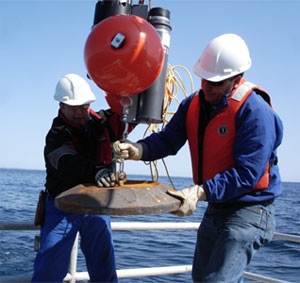 |
| Researchers prepare to place a tracking device, part of the Ocean Tracking Network. |
For years, scientists have struggled to understand the decline of Atlantic salmon and what happens to them once they reach the ocean. For the first time, there is hope some answers will be found.
Between June 10 and June 23, Atlantic salmon tagged with tiny acoustic transmitters crossed the 22 km line of acoustic receivers, deployed by the Ocean Tracking Network (OTN), in the waters off of Halifax, Nova Scotia. The fish, tagged by The National Oceanic and Atmospheric Administration (NOAA), and the United States Geological Survey (USGS) in the Penobscot River in Maine, sent signals to the receivers, and information about their passage was then downloaded from the receivers to a Fisheries and Oceans Canada (DFO) research vessel via modem.
“In Maine, traditional methods of restoring Atlantic salmon by stocking fish have not been very successful, with only 0.68 per cent returning,” says Mike Stokesbury, director of research for OTN, headquartered at Dalhousie University, Nova Scotia. “With the tagged salmon we can track more fish further into the ocean than ever before and get meaningful results,” he explains.
One hundred salmon were tagged in Maine USA with 9mm transmitters in the Penobscot River. About 30 per cent of their signals were picked up by OTN receivers deployed by DFO off Halifax. Each fish has an individual code and gives specific information about its activity such as survival rates, speed and migratory habits. The information has shown that while some salmon may die before reaching Halifax, many still survive.
The first downloads gave valuable information about when the salmon left the Penobscot River and estuaries. “We’re not sure where they go in-between, but we’re hoping to find that out,” says Mr. Stokesbury. “The salmon crossing the line is evidence that the network is working,” adds Peter Smith, a scientist at the Bedford Institute of Oceanography (BIO) and the DFO lead for the Halifax Line. Some tagged salmon may have not yet crossed the line while others may have gone beyond it, but they may be detected again when they cross the Atlantic Salmon Federation (ASF) line at Strait of Belle Isle, Labrador.
“Given the fact that we are looking for a fish that is still less than a foot long that could be anywhere in the Northwest Atlantic Ocean, finding them in such apparent concentrations hundreds of miles from Brewer, Maine is remarkable and very encouraging,” said John Kocik, who is leading the salmon tagging project with colleague James Hawkes at the NOAA Northeast Fisheries Science Centre’s Maine Field Station in Orono, Maine. “Broad-scale ocean arrays such as the OTN Halifax Line are a great tool to examine the marine ecology of such an uncommon fish in a large marine environment.”
Institutions and organizations such as BIO, DFO, USGS, ASF, NOAA and Dalhousie University are all part of the OTN effort to determine what’s happening to the salmon stocks. The first detection on the Halifax Line was recorded May 18 from a salmon tagged in Nova Scotia’s Medway River by a Fisheries and Oceans Canada researcher at BIO. The Halifax line also recorded a salmon tagged by ASF researchers in the spring in the Magaguadavic River, a Canadian river near the Maine-New Brunswick border. This fish crossed the Bay of Fundy and passed Halifax, presumably on the way to feed off the coast of Greenland.
“Salmon are an iconic fish, but they’re becoming endangered and people want to know what’s happening to the population,” says Mr. Stokesbury. “This is the first step to finding out where in the ocean the salmon are dying and what’s causing the decline.”
Similar results are being seen by the OTN’s West Coast partner in the Pacific Ocean Shelf Tracking (POST) project, of the Census of Marine Life. In addition to salmon, OTN researchers around the world and as far away as Australia are tagging marine life, from squid to turtles, with transmitters in an effort to finally provide ocean scientists around the world with the most comprehensive information about our oceans and marine life. Information about the OTN can be found at oceantrackingnetwork.org.
LINK: Ocean Tracking Network
